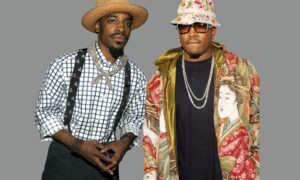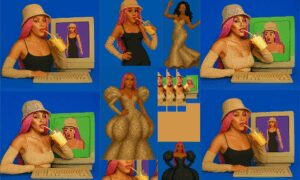
Killa Thesis: Pink Minks, Soul Loops & Sense That Don’t Make Sense (’til It Does)
It’s been a minute since Cam’ron truly mattered on the charts, but in the early 2000s, he mattered a lot to a lot of hip hop heads. The Harlem-raised rapper earned respect, record sales, and even a Bill O’Reilly face‑off by casually delivering internal, nursery‑rhyme cadences that mixed absurdism with the directness of a death certificate, and a charisma entirely his own. It’s like Cam took David Byrne’s “Stop Making Sense,” applied it, flipped the nonsense back into sense, loaded a magazine of that sense, and dumped clips over menacing knock, chipmunk soul, and bright melodies.
He’ll pivot from cartoonish to cold‑eyed in two bars—“Give me the mac… / Tell Mr. Rogers, I leave his brains on the trolley track”—and make it all sound inevitable.
Behold, Utah Jazz fans and Fox News haters:
Cam’s voice is the paradox: stripped-down literary absurdism and love of language like Donald Barthelme, mixed with street realism, and straight-up trolling. In a slightly alternate timeline, he’s a top‑ten MC ever. In this one, he was unstoppable from roughly 2002 to 2006: Dipset freestyles, TV money-counting flexes, degenerate quotables, the whole Harlem pageant.
Behold, the legendary Rap City Freestyle:
Uptown Origins: From Lenox to Labels (Children of the Corn → S.D.E.)
The origin story begins in the mid-’90s with Children of the Corn, Cam alongside Big L and Ma$e, featuring Harlem cyphers with a Wu-adjacent menace. Then comes the Biggie‑blessed solo runway: Confessions of Fire (’98). It had moments (and an all‑timer cover), but you could hear the tug-of-war between what Cam was and what execs wanted him to be, a solid debut, not yet a mission statement.
The mission statement arrives with the Trilogy Test. Very few rappers ever drop three great albums in a row. However, you argue the canon, Cam’s turn‑of‑the‑century run belongs on that short list, starting with S.D.E. (Sports, Drugs & Entertainment) in 2000. From the very first seconds, Cam gets to the point, rudely, and then starts itemizing everything and everyone who can kick rocks. Over triumphant, Motown‑tinged loops, he marries crass (the talk) to class (the samples). That contrast, filthy, funny bars over elegant strings, becomes his calling card.
Just as important, he slows down and enunciates. The bars breathe, the internal rhymes bloom, and the punchlines land with a smirk. Others might out‑gymnast him technically; you’d still rather be Cam. The swagger turns into an instrument.
Diplomatic Immunity: Roc-A-Fella Shine & the Purple Haze Peak
In 2001, Cam slides to Roc‑A‑Fella, the hottest label in rap. Come Home With Me (2002) blows the doors open: radio dominance, a #2 chart peak, and heavyweight sampling from Just Blaze and a young Kanye. “Oh Boy” and “Hey Ma” become jukebox malware—uninstallable, humming in your head for weeks.
If Come Home made him a star, Purple Haze (2004) turned him into a legend. It doesn’t reinvent Cam so much as perfect his recipe. You get the gospel‑soul chop, the cathedral horns, the attitude so petty it’s practically performance art. Even the skits are actually funny: a strung‑out Greek chorus named Mizzle drops a street catechism—
“If you’re going to steal, rob the stash house.”
Go big or go back to Harlem. On Purple Haze, Cam does both.
Take ‘Em to Church
Take, for example, “Take ‘Em to Church,” a beat that splits the difference between the aforementioned three styles:
Listen, ya’ll stop it (stop)
Know you appalled, got it
But this my call by the false prophets, all profit (all profit)
Harlem hustler (yep), I can’t knock it (nope)
But you hard, when you go in the lord’s pocket.
What you offering, put it, right in offerin
They take it all: cash, credit, silver, down to porcelain
Look at the Porsche he’s in (look at it)
Then give them portioning (to Who?)
No handicap, Annie Rag, orphan friends
Friends, but the sizzurp I’m drinking on
Birds I’m thinking on
Get your Kirk Franklin on
Word, so you get your Ben Franklin on
Just when you think it’s wrong
One blink, he’s gone (damn)
This is a diss song aimed toward Ma$e, a former friend of Cam’s. Without rapgenius.com or a deep familiarity with the trials and tribulations of Cam’ron, most wouldn’t pick up the hints, but considering the two rappers’ fallout and Ma$e’s transition from emcee to minister, the verse’s purpose is apparent. Although the target is obscured, the point is not. Cam wants people to:
- Watch out for church leaders who are in it for the money
- not that hustlin’ is inherently bad
- he supports hustling in most forms
- but you shouldn’t use the Lord to get over on people
Dipset & Pink
Meanwhile, The Diplomats become a cultural machine. They treat Rap City like theater; the no‑DJ mixtape ethos hardwires the “content is king” age long before social feeds gamified everything. Then there’s the pink mink + matching Range Rover—a single image that detonates fashion rules and makes Killa Pink a policy. It wasn’t just flex; it was a cheat code for virality before the algorithm had a name.
“Harlem Shake at your wake.” — “Down & Out”
Harlem Globetrotter Energy: The Rodman Parable (Because Why Not)
Dennis Rodman once lived the side‑quest dream: Jordan’s wingman, wrestling cameos, tabloid romances, and action movies. If that list doesn’t move you, you might be too old, too young, or not enough of a teenage boy from the ’90s to feel how absurdly complete that résumé is.
Cam has his own bucket list: rapping with Big L and Ma$e; that early co‑sign pipeline via Biggie; the pink‑fur iconography; three in a row that are either classic or within shouting distance. Waka Flocka cites him openly; you can hear his smart‑aleck DNA in Das Racist, Earl Sweatshirt, and any rapper who leans into internal rhymes with a side‑eye.
Killa’s Junk Drawer: When Cam’ron Happened to Cam’ron
But even kings catch elbows. Cam’s slide wasn’t a cliff, it was a junk drawer of minor disasters: beefs with Jay‑Z and Kanye; Dipset fractures; label musical chairs. And at near‑peak heat, he stepped away for three years to take care of his ailing mother. The human move was real; the momentum loss was, too.
Killa Season should’ve been another coronation. Instead, the beats felt dulled at points, and Cam sounded tired in places. The ingredients were all there—rimshots, strings, sugar‑rush piano—but the spark hiccuped. Crime Pays (2009) and the Vado collab that followed delivered a handful of keepers, but no rally. The classic trilogy never got its fourth chapter.
Still, the idea of inevitability? Nah. Cam’s too savvy, too funny, too naturally charismatic for “washed” to be destiny. In some parallel timeline, he parlayed 2004 into Jay‑Z‑level moguldom. In ours, the timing and politics just didn’t break his way.
Essential Cam’ron Playlist
Camcorder (Press Record): Time‑Travel to 2014, Then Forward
Then the pink shadow moved again. Around 2014, Cam drops “Humphrey” with A-Trak—pure Purple Haze bounce—and doubles down with “Dipshits” (featuring Just Blaze, Juelz, and that old Harlem static). The internet goes nuts, which is poetic, because Cam basically fathered the blog‑era dialogue in the first place. He follows with the 1st of the Month EPs: not world‑shaking, but rich with Cam‑isms and catered to the faithful. Not reinvention—reaffirmation.
Holy Ma$e‑trimony: It Is What It Is & the Harlem Sports Desk
Then Cam did the most Cam thing possible: turned barbershop talk into a sports franchise.
With fellow Harlemite Ma$e, Cam launched It Is What It Is, a sports talk show that’s essentially Dipset energy in ESPN clothing, unfiltered takes, immaculate Harlem timing, and quotables designed to ricochet across timelines. The chemistry is its own offense: Cam’s wry sting, Ma$e’s preacher‑slick delivery, and Treasure “Stat Baby” Wilson calling plays, pressing the shot‑clock when the takes dribble into overtime. The result? Not just clips—community. A core audience that shows up like it’s playoff basketball.
And because the show understands spectacle, it leaned into “we really booked him?” moments, most infamously, bringing on O.J. Simpson in late 2023 as a recurring football analyst/correspondent. That choice did exactly what it was engineered to do: numbers and noise. People watched, people argued, and the “is this too far?” discourse followed them around like paparazzi. After Simpson’s death in April 2024, Cam and Ma$e posted a tribute, acknowledging he’d become “Uncle O” to the crew. You don’t have to love the decision to respect the show’s understanding of how modern attention works: be compelling, be conversational, and, crucially, be unmistakably you.
The bigger headline isn’t just controversy; it’s conversion—of persona into platform. It Is What It Is proves that the same instincts that made Cam a mixtape general translate to the sports desk: pacing, punchlines, and a sixth sense for what makes people lean closer to the screen.
Harlem Endgame: Why Cam Still Matters
Cam’ron didn’t just catch a wave—he taught people how to surf the absurd. He perfected the crass‑and‑class aesthetic (nasty bars over operatic strings), minted a Harlem fashion mythos (pink as tactical gear), built a trilogy that passes the three‑album stress test, and then re‑wrote the late‑career playbook by turning barbershop talk into a sports property with real gravity.
He may never again own a year the way he owned 2003–2005, but he doesn’t need to. The influence is baked in: slang, swagger, internet cadence, the permission structure for being ridiculous and razor‑sharp at once. If you’re tracing the bloodline of modern talk‑your‑talk rap and viral sports chatter, there’s a pink thread running through it. That’s Cam. Dipset forever.
Appendix: Essential Cam for the Ride Home (Linear, No Skips)
- S.D.E. (2000) – The manifesto/switch‑up; slow flow, heavy emphasis, pure attitude.
- Come Home With Me (2002) – The coronation; “Oh Boy,” “Hey Ma,” mainstream shine without shedding Harlem.
- Purple Haze (2004) – The opus; maximal Cam—grand, grimy, gleeful.
- Singles/Runbacks (2014 era) – “Humphrey,” “Dipshits,” and the 1st of the Month EPs — vintage flavor, modern polish.
- Deep‑cut vibe check – The Rap City freestyles (counting money), and the Dipset cyphers that turned living rooms into Harlem for 5 minutes.










